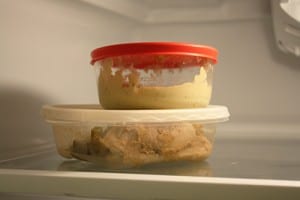
When the power flickers and then completely goes out, your first instinct is to find a flashlight or light candles. Being able to see is a priority but, what you may not know is that bacteria will begin growing in perishable foods when the electricity is off.
During the winter season, severe snow and ice storms damage outdoor utility lines, and storing food safely becomes a challenge if the power goes out. The U.S. Department of Agriculture (USDA) recommends these steps to follow before and during a power outage.
Prepare Ahead of Time
- Appliance thermometers. Make sure you keep appliance thermometers in both the refrigerator and the freezer. That’s the best way to be sure that your food is safe after a power outage. Safe temperatures are 40 °F or lower in the refrigerator; 0°F or lower in the freezer.
- Freeze water in one-quart plastic storage bags or small containers. They are small enough to fit in around the food in the refrigerator and freezer to help keep food cold and won’t make a mess when the ice melts. Don’t fill them too full. Because water expands when it freezes, the bags might split. Make extra ice at home.
- Freeze refrigerated items such as leftovers, milk and fresh meat and poultry that you may not need immediately. This helps keep them at a safe temperature longer.
- Dry ice or block ice. Know where you can get them.
- Have coolers on hand to keep refrigerator food cold if the power will be out for more than 4 hours.
- Group foods together in the freezer; this helps the food stay cold longer. They form an “igloo” to protect each other.
- Don’t put food outdoors in ice or snow because wild animals may be looking for a meal, and when the sun comes out it may warm your food to an unsafe temperature.
- Stock up on ready-to-eat foods. Be sure to have a few days’ of foods that do not require cooking or cooling.
When the Power Goes Out
- Keep the refrigerator and freezer doors closed as much as possible. A refrigerator will keep food cold for about 4 hours if the door is kept closed.
- A full freezer will hold its temperature for about 48 hours (24 hours if half-full).
- Place frozen meat and poultry on a tray so that if they begin thawing, their juices will not drip on other foods.
- Buy dry or block ice if the power is going to be out for a long time. Ice will keep the refrigerator as cold as possible. Fifty pounds of dry ice should keep a fully-stocked 18-cubic-feet freezer cold for two days.
When Power Comes Back On
- Check the temperature inside your refrigerator and freezer. Discard any perishable food (such as meat, poultry, seafood, eggs, or leftovers) that has been above 40 °F for two hours or more.
- Check each item separately. Throw out any food that has an unusual odor, color, or texture, or feels warm to the touch.
- Check for ice crystals in frozen food. The food in your freezer that partially or completely thawed may be safely refrozen if it still contains ice crystals or is at 40 °F or below.
- Never taste a food to decide if it’s safe.
- When in doubt, throw it out.
See these charts to help you evaluate specific foods
- Refrigerated Foods: When to Save and When to Throw Out
- Frozen Food and Power Outages: When to Save and When to Throw Out
For more information about food safety in an emergency, check out these resources:
- A Consumer’s Guide to Food Safety: Severe Storms and Hurricanes (USDA)
- Video Link: Food Safety During a Power Outage
- In an Emergency (FoodSafety.gov)